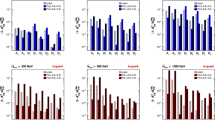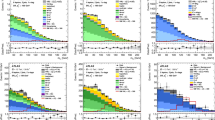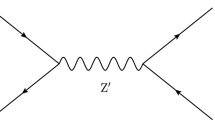Abstract
The first string excited state can be observed as a resonance in dijet invariant mass distributions at the LHC, if the scenario of low-scale string with large extra dimensions is realized. A distinguished property of the dijet resonance by string excited states from that the other “new physics” is that many almost degenerate states with various spin compose a single resonance structure. It is examined that how we can obtain evidences of low-scale string models through the analysis of angular distributions of dijet events at the LHC. Some string resonance states of color singlet can obtain large mass shifts through the open string one-loop effect, or through the mixing with closed string states, and the shape of resonance structure can be distorted. Although the distortion is not very large (10% for the mass squared), it might be able to observe the effect at the LHC, if gluon jets and quark jets could be distinguished in a certain level of efficiency.
Similar content being viewed by others
References
I. Antoniadis, A possible new dimension at a few TeV, Phys. Lett. B 246 (1990) 377 [SPIRES].
I. Antoniadis, String physics at low energies, Prog. Theor. Phys. Suppl. 152 (2004) 1 [SPIRES].
I. Antoniadis, Topics on string phenomenology, arXiv:0710.4267 [SPIRES].
I. Antoniadis, K. Benakli and M. Quirós, Radiative symmetry breaking in brane models, Nucl. Phys. B 583 (2000) 35 [hep-ph/0004091] [SPIRES].
N. Kitazawa, Radiative symmetry breaking on D-branes at non-supersymmetric singularities, Nucl. Phys. B 755 (2006) 254[hep-th/0606182] [SPIRES].
S. Cullen, M. Perelstein and M.E. Peskin, TeV strings and collider probes of large extra dimensions, Phys. Rev. D 62 (2000) 055012 [hep-ph/0001166] [SPIRES].
L.A. Anchordoqui et al., Dijet signals for low mass strings at the LHC, Phys. Rev. Lett. 101 (2008) 241803[arXiv:0808.0497] [SPIRES].
L.A. Anchordoqui, H. Goldberg and T.R. Taylor, Decay widths of lowest massive Regge excitations of open strings, Phys. Lett. B 668 (2008) 373[arXiv:0806.3420] [SPIRES].
L.A. Anchordoqui et al., LHC phenomenology for string hunters, Nucl. Phys. B 821 (2009) 181[arXiv:0904.3547] [SPIRES].
D0 and CDF collaboration, T. Nunnemann, Searches for leptoquark production and compositeness at the Tevatron, PoS(EPS-HEP 2009)268 [arXiv:0909.2507] [SPIRES].
D. Lüst, S. Stieberger and T.R. Taylor, The LHC string hunter’s companion, Nucl. Phys. B 808 (2009) 1[arXiv:0807.3333] [SPIRES].
J. Pumplin et al., New generation of parton distributions with uncertainties from global QCD analysis, JHEP 07 (2002) 012 [hep-ph/0201195] [SPIRES].
N. Boelaert and T. Akesson, Dijet angular distributions at \( \sqrt {s} = 14\,TeV \), Eur. Phys. J. C 66 (2010) 343[arXiv:0905.3961] [SPIRES].
I. Antoniadis, E. Kiritsis and J. Rizos, Anomalous U(1)s in type-I superstring vacua, Nucl. Phys. B 637 (2002) 92[hep-th/0204153] [SPIRES].
Author information
Authors and Affiliations
Corresponding author
Additional information
ArXiv ePrint: 1008.4989
Rights and permissions
About this article
Cite this article
Kitazawa, N. A closer look at string resonances in dijet events at the LHC. J. High Energ. Phys. 2010, 51 (2010). https://doi.org/10.1007/JHEP10(2010)051
Received:
Accepted:
Published:
DOI: https://doi.org/10.1007/JHEP10(2010)051




